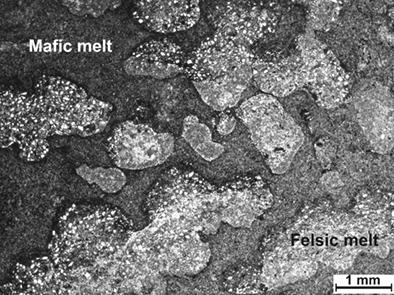当前位置:
X-MOL 学术
›
Geolog. J.
›
论文详情
Our official English website, www.x-mol.net, welcomes your feedback! (Note: you will need to create a separate account there.)
Geochemical evidence of mixing between A‐type rhyolites and basalts from Southern Lebombo, South Africa: Implications for evolution of the Northern Karoo Igneous Province
Geological Journal ( IF 1.8 ) Pub Date : 2020-09-21 , DOI: 10.1002/gj.3970 Saumitra Misra 1 , Alan Smith 1 , Dwijesh Ray 2 , Warwick W. Hastie 1
Geological Journal ( IF 1.8 ) Pub Date : 2020-09-21 , DOI: 10.1002/gj.3970 Saumitra Misra 1 , Alan Smith 1 , Dwijesh Ray 2 , Warwick W. Hastie 1
Affiliation

|
The ~183 Ma Karoo Continental Flood Basalt (CFB), southern Africa, formed during a period of major crustal extension prior to Gondwana breakup. To explain the ‘lithospheric contamination’ observed in its whole‐rock chemical and isotopic data various models have been proposed, such as different subcontinental lithospheric mantle (SCLM) sources or interaction between a mantle plume and SCLM or subducted material. A re‐assessment of data in the literature from the Northern Karoo Province, combined with new petrographic, whole‐rock chemical and Sr‐Nd isotopic data of basaltic and dacite/trachydacite samples from the southern Lebombo suggest that chemical diffusion between low‐Ti basaltic/picritic magmas and high‐SiO2 rhyolite parent melt may have caused this ‘lithospheric contamination’. Such slow chemical diffusion, which is posited to have developed during formation of this CFB, can explain the bimodal Karoo basalt‐rhyolite association, the wide variation in SiO2 content (~62–78 wt%) in the dacite/rhyolites, and variable 87Sr/86Sr (183 Ma) and ɛNd (183 Ma) isotope ratios of the Karoo picrites and basalts (0.7037 to 0.7102; 3.58 to −33.52, respectively) and dacites/rhyolites (0.7032 to 0.7152; 0.44 to −17.19). The intermediate incompatible trace element and isotopic compositions of the Karoo high‐Ti basalt/picrite suggest that these rocks could have evolved by magma mixing through chemical diffusion. Our geochemical model for the northern Karoo CFB province involves existence of a voluminous hot (>1,000°C) low‐Ti basaltic magma chamber with remnant picritic melts at shallow crustal depth (~4 km) during major crustal extension. Magma storage was relatively protracted, resulting in significant volumes of partial melt of the surrounding granitoids of the Kaapvaal Craton under relatively anhydrous condition, leading to generation of A‐type high‐SiO2 rhyolite parent magma at pressure of ~1.5 kbar and temperature of ~930°C. This was followed by chemical diffusion of selected elements [LREE, HFSE, and some LILE (K, Rb, Ba, Pb)] and self‐diffusion of Sr and Nd isotopes in these two melts, which generated the observed litho‐type variations in Karoo CFB.
中文翻译:

南非莱博姆南部A型流纹岩与玄武岩混合的地球化学证据:对北部卡鲁火成岩省演化的启示
南部非洲约183 Ma Karoo大陆洪水玄武岩(CFB),是在冈瓦纳解体之前的一个主要地壳扩展期形成的。为了解释在其全岩石化学和同位素数据中观察到的“岩石圈污染”,已经提出了各种模型,例如不同的亚大陆岩石圈地幔(SCLM)来源或地幔柱与SCLM或俯冲物质之间的相互作用。对北部卡鲁省文献的数据进行了重新评估,并结合了来自勒博姆南部的玄武岩和闪锌矿/长晶石样品的新的岩石学,全岩化学和Sr-Nd同位素数据,表明低钛玄武岩之间的化学扩散/微岩浆和高SiO 2流纹岩母体熔体可能引起了这种“岩石圈污染”。这种缓慢的化学扩散(可能是在这种CFB形成过程中形成的)可以解释双峰型Karoo玄武岩-流纹岩的缔合,菱铁矿/流纹岩中SiO 2含量的广泛变化(〜62–78 wt%)以及可变性。87 SR / 86的Sr (183马)和ɛ钕(183 Ma)的卡鲁(Karoo)微晶岩和玄武岩的同位素比(分别为0.7037至0.7102; 3.58至-33.52)以及水辉石/流纹岩(0.7032至0.7152; 0.44至-17.19)。中间的不相容的微量元素和Karoo高钛玄武岩/苦粉矿的同位素组成表明,这些岩石可能是通过化学扩散的岩浆混合而演化的。我们在卡鲁CFB北部省份的地球化学模型中涉及到一个大的热(> 1,000°C)的低钛玄武岩浆室的存在,在大地壳扩展期间,浅地壳深度(约4 km)中残留有苦rit质熔体。岩浆储存相对旷日持久,导致在相对无水的条件下,Kaapvaal Craton周围花岗岩的大量部分熔融,导致产生A型高SiO 2流纹岩母岩浆的压力约为1.5 kbar,温度约为930°C。随后是选定元素[LREE,HFSE和某些LILE(K,Rb,Ba,Pb)]的化学扩散,以及Sr和Nd同位素在这两个熔体中的自扩散,从而产生了观察到的岩石类型变化。卡鲁CFB。
更新日期:2020-09-21
中文翻译:

南非莱博姆南部A型流纹岩与玄武岩混合的地球化学证据:对北部卡鲁火成岩省演化的启示
南部非洲约183 Ma Karoo大陆洪水玄武岩(CFB),是在冈瓦纳解体之前的一个主要地壳扩展期形成的。为了解释在其全岩石化学和同位素数据中观察到的“岩石圈污染”,已经提出了各种模型,例如不同的亚大陆岩石圈地幔(SCLM)来源或地幔柱与SCLM或俯冲物质之间的相互作用。对北部卡鲁省文献的数据进行了重新评估,并结合了来自勒博姆南部的玄武岩和闪锌矿/长晶石样品的新的岩石学,全岩化学和Sr-Nd同位素数据,表明低钛玄武岩之间的化学扩散/微岩浆和高SiO 2流纹岩母体熔体可能引起了这种“岩石圈污染”。这种缓慢的化学扩散(可能是在这种CFB形成过程中形成的)可以解释双峰型Karoo玄武岩-流纹岩的缔合,菱铁矿/流纹岩中SiO 2含量的广泛变化(〜62–78 wt%)以及可变性。87 SR / 86的Sr (183马)和ɛ钕(183 Ma)的卡鲁(Karoo)微晶岩和玄武岩的同位素比(分别为0.7037至0.7102; 3.58至-33.52)以及水辉石/流纹岩(0.7032至0.7152; 0.44至-17.19)。中间的不相容的微量元素和Karoo高钛玄武岩/苦粉矿的同位素组成表明,这些岩石可能是通过化学扩散的岩浆混合而演化的。我们在卡鲁CFB北部省份的地球化学模型中涉及到一个大的热(> 1,000°C)的低钛玄武岩浆室的存在,在大地壳扩展期间,浅地壳深度(约4 km)中残留有苦rit质熔体。岩浆储存相对旷日持久,导致在相对无水的条件下,Kaapvaal Craton周围花岗岩的大量部分熔融,导致产生A型高SiO 2流纹岩母岩浆的压力约为1.5 kbar,温度约为930°C。随后是选定元素[LREE,HFSE和某些LILE(K,Rb,Ba,Pb)]的化学扩散,以及Sr和Nd同位素在这两个熔体中的自扩散,从而产生了观察到的岩石类型变化。卡鲁CFB。

























 京公网安备 11010802027423号
京公网安备 11010802027423号